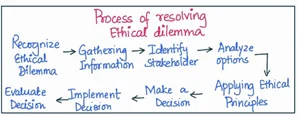Answer:
| Approach:
Introduction
- Write about ethical dilemmas.
Body
- Mention the examples of ethical dilemmas in Public Administration.
- Steps to resolve ethical dilemmas in Public Administration.
Conclusion
- Conclude accordingly with the way forward.
|
Introduction:
Public administration is a field that often presents complex ethical dilemmas due to the intersection of power, accountability, and public interest. Resolving ethical dilemmas in this context requires a systematic approach that balances competing values and interests.
Body:
Examples of ethical dilemmas in Public Administration:
- A public official must decide whether to disclose confidential information that could prevent a serious crime from occurring.
- A public servant must choose between honoring a superior’s orders and upholding the law.
- A public official must decide whether to award a contract to a friend or family member who is not the most qualified bidder.
- A public servant must decide whether to follow the official protocol or bend the rules to accommodate a VIP.
- A public servant must decide whether to accept a gift from a private company that is seeking to influence a decision.
The process of resolving ethical dilemmas in Public Administration involves the following steps:

- Recognize the ethical dilemma: The first step is to identify the ethical issue at hand and acknowledge that it needs to be addressed.
- Gather information: Collect all relevant information about the dilemma, including any laws, policies, and guidelines that apply.
- Identify stakeholders: Determine the individuals or groups that may be affected by the decision, including those who may be harmed or benefited.
- Analyze options: Consider all the possible options and evaluate the advantages and disadvantages of each option.
- Apply ethical principles: Use ethical principles such as honesty, fairness, and respect for human dignity to guide the decision-making process.
- Make a decision: Choose the course of action that best aligns with the ethical principles and has the greatest positive impact on stakeholders.
- Implement the decision: Once the decision has been made, take action to implement it and monitor its impact.
- Evaluate the decision: Evaluate the effectiveness of the decision and make any necessary adjustments.
Conclusion:
By following this process, public servants can make decisions that are in the best interest of the public while upholding ethical principles. Ultimately, a transparent and accountable decision-making process is crucial to building trust and promoting ethical behavior in public administration.
| Value Addition:-
Ethical Dilemma: An ethical dilemma refers to a situation in which a person is faced with a difficult choice between two or more conflicting moral principles or courses of action, each with potential positive and negative consequences.
Example:-
- Whistleblowing: An employee discovers their supervisor engaging in fraudulent activities. They face an ethical dilemma of whether to report the wrongdoing, risking their job and personal safety, or to remain silent, compromising their integrity.
|
